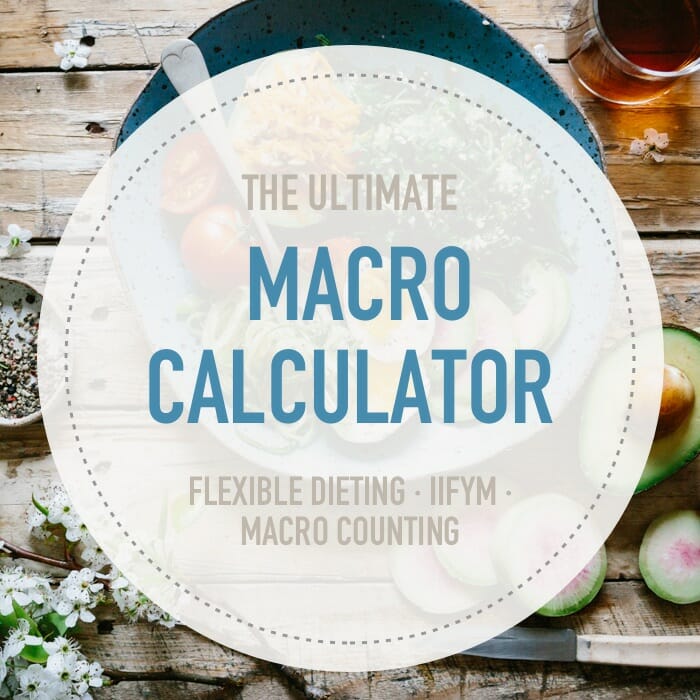
This macro calculator is designed by flexible dieters for flexible dieters. Flexible dieting is sometimes called IIFYM (If It Fits Your Macros).
Use it to calculate your optimal macronutrient ratios based on your age, height, weight, gender, and activity level. Then use your results with flexible dieting or IIFYM and count macros to lose weight, maintain, or gain muscle.
Lose, Maintain, or Gain?
This macro calculator gives you the ability to adjust your macros at 4 different goal settings.
- Lose puts you in a 20% calorie deficit which promotes safe, steady weight loss.
- Lose 10% puts you in a 10% calorie deficit and is intended for those with less than 10 pounds to lose and who also wish to build muscle at the same time.
- Maintain allows you to eat at macro levels that will keep you at your current weight.
- Gain puts you in a 20% calorie surplus and is designed for people who are wanting to build muscle fast in conjunction with a comprehensive weight training program. It can also be used by people who are underweight.
What Are My Macros?
The following formula is used:
- Protein ratio is set at .825 grams per pound of bodyweight.
- Fats are set at 25% of daily energy expenditure.
- Carbohydrate grams come from the remainder.
Daily energy expenditure is calculated from your age, gender, height, weight, and exercise output.
Which IIFYM Formula?
The default formula is fine for most people. However, there are some exceptions.
1. If you are very lean (low body fat percentage) the standard formula may not be accurate. Use the “Lean Body Mass” setting. This uses a formula that factors specific body fat percentage into the equation and since muscle tissue burns many more calories than fat tissue while even at rest, it will give you a higher TDEE. This is perfect for “athletic body types” that want to use IIFYM to gain more muscle mass.
2. If you are classified as obese and have a lot of weight to lose, the standard formula will not be accurate because the equation used, factors for an average body fat percentage. If you happen to be above average it will skew the results. Please see this article for more clarification on how to do flexible dieting if you are obese.
You can calculate your ideal body weight here.
Adjusting Protein
Setting protein to Low adjusts the ratio to .65 grams per pound of body weight. Higher will set to 1 gram / lb.
Higher protein levels may be helpful if you have a strength training component in your IIFYM exercise routine. There are many differing opinions about this.
Try starting at the Normal level. If however you do a lot of lifting (3 times a week or more), then set to the High level.
Counting Macros per Meals per Day
By default, the results show the amount of grams of macronutrient should be eaten each day. Click on meal numbers to split this into a “per meal” basis for counting macros.
IIFYM Goals
By default, the results are for maintaining weight with IIFYM. Select either lose or gain if you are trying to lose fat or gain muscle. These are good starting points, but since IIFYM is highly individualized, you may have to play around with your macros until you find your personal goal reaching sweet spot. You can then count macros until you reach your desired goal.
Activity Level
A higher level activity means a higher daily calorie goal (TDEE). For example; if you can maintain your weight at 2,000 calories per day, then adding vigorous daily exercise to this means you need more calories to maintain your weight.
The same rule applies even if your flexible dieting goal is to lose weight.
If you are sedentary and your goal is to lose weight, your calorie goal might be (for example) 1,600 calories per day. If you decide to start exercising, the calculator will increase your daily calorie goal (say, to 1,800 calories/day). Although it may seem counter-intuitive, more energy is required to fuel your workouts, and your metabolism is increased – therefore calories should be higher.
Many people struggle with which exercise level to choose. Basically each level breaks down as follows:
This varies based on your individual stats, but you can get a more specific amount of calorie burn by simply subtracting your sedentary calorie amount from the chosen exercise level amount.
You also need to determine how many calories you are burning: For this use an exercise database or a good app like MapMyFitness or a device like FitBit.
Too much physical activity combined with low calories could lead to muscle catabolism (breakdown of muscle fiber). This is not a good thing, and can actually stall your weight loss, so eat up!
If you need some inspiration, check out these incredible transformation stories of from people who used counting macros to reach their goals and get started with flexible dieting or IIFYM today.
You'll Love Our Programs
Step-by-step ebooks, or fully customized personal coaching. Let us help you succeed!



References
- Mifflin, M. D., St Jeor, S. T., Hill, L. A., Scott, B. J., Daugherty, S. A., & Koh, Y. O. (1990). A new predictive equation for resting energy expenditure in healthy individuals. The American Journal of Clinical Nutrition, 51 (2), 241-247. Link
- McArdle, W. D., Katch, F. I., & Katch, V. L. (2010). Exercise physiology: nutrition, energy, and human performance. Lippincott Williams & Wilkins. Link
- Lemon, P. W., Tarnopolsky, M. A., MacDougall, J. D., & Atkinson, S. A. (1992). Protein requirements and muscle mass/strength changes during intensive training in novice bodybuilders. Journal of Applied Physiology, 73(2), 767-775. study abstract link
Original article and pictures take https://healthyeater.com/flexible-dieting-calculator site

Комментариев нет:
Отправить комментарий